Other named plants of this type that I have are. -
- Alice
- Altenstenii
- Althena
- Angel Wings
- Aspen....................wide white frilly petals
- Ballerina
- Bella
- Ben
- Bridgeport...............white
- Bristol Amber
- Bristol Queen
- Britta
- Butterfly, 'Madame'......white with cerise edge
- Butterfly Magic
- Butterfly Sunset
- Cancan
- Carmen
- Celeste
- Chantelle
- Cherry
- Christmas Charm
- Christmas Cheer
- Christmas Fantasy....... orange
- Coral Cascade
- Duchess
- Dusty Pink
- Electra
- Eren
- Fiesta
- Glorious
- Gold Charm
- Gold Fantasy
- Heatherton Charm
- Janelle
- Just Peachy
- Kitt
- Lady Lavendar
- Lady Linda
- Latin Lady
- Lavendar Fantasy
- Le Jesuv
- Line
- Lipstick
- Lois
- Madam Ganna Walska
- Magic Fantasy
- Majestic
- Marie
- Marie, dark
- Marylou
- Mascot
- Mia
- Milissa
- Milkuli
- Miranda
- Mitchell
- Millenium Fantasy
- Mother's Day
- Mystic
- Naomi
- Nille
- Olga
- Orange Devil
- Orange Fantasy
- Orange Glory
- Orange Wings
- Pasadena
- Purple Pyramid
- Rebecca
- Rhapsodie
- Rita
- Ruby
- Sanibel
- Santa Cruz
- Savannah
- Singapore
- Sleigh Bells
- Sonata
- Stars & Stripes
- Stephanie
- Sunburst Fantasy
- Susan
- Symphony
- Thoratina
- Tina
- Tropical Sunset
- Twilight Tangerine
- Vida
- White Fantasy
- Windsor
Care and Cultivation - thanks to Epiflora
The "true" Christmas Cactus is an interspecific hybrid
of Schlumbergera truncata and Schlumbergera russelliana
that originated about 150 years ago in England.
Plants have segments with rounded margins,
ribbed ovaries, and purplish-brown anthers.
The correct Latin name for christmas Cactus is Schlumbergera x buckleyi;
the :"x" indicates that it is an interspecific hybrid. Most commercial cultivars of holiday cactus are actually
Schlumbergera truncata, commonly known as Thanksgiving Cactus or Zygocactus.
Thanksgiving Cactus has segments with conspicuous teeth on the margins,
rounded ovaries with no ribs, and yellow anthers.
Under natural photoperiods, Thanksgiving Cactus flowers
about 4 to 6 weeks earlier than Christmas Cactus. Some cultivars of holiday cactus are derived from crossing
Christmas Cactus and Thanksgiving Cactus, and have
characteristics that are intermediate between the parents.
(OK - are you as confused as me)
It is a native plant of Brazil. In their natural
habitat these plants grow on trees in cracks and crevices,
and therefore make very good hanging baskets.
Propagation: is by rooting mature single-segment cuttings.
Cuttings should be removed from the plants by twisting the segments
180 deg. and pulling upwards. Collect cuttings in clean pathogen-free containers.
They can be surface-disinfected by a five-minute dip in diluted
bleach followed by a thorough rinsing in tap water.
They can be stored up to three months at 10 - 15 deg. C and 90 - 95% humidity.
Cuttings are best propagated between June and September(or after flowering has finished).
Growing medium: use one that is high in organic matter, well drained,
and adjusted to a pH of 5.7 - 6.5. Use soil sterilised rooting
material with the odd burst of fungicide.
 Flowering: this is controlled by photoperiod (light) and temperature.
In natural conditions this is initiated in March when the day length shortens
i.e. it is the longer nights that trigger flowering, not the shorter days,
and temperatures are around 10 - 15 deg.C.
Flowering: this is controlled by photoperiod (light) and temperature.
In natural conditions this is initiated in March when the day length shortens
i.e. it is the longer nights that trigger flowering, not the shorter days,
and temperatures are around 10 - 15 deg.C.
If you have white or yellow flowering plants these need to be kept in an even warm temperature,
If they become too cold the flowers will turn pink.

This is a shot of 'Gold Fantasy' which flowered in May 2001
Watering: Frequency depends on environmental conditions, type of growing
medium and plant establishment. Well established plants may need to be
irrigated every 2-3 days in summy warm weather or 5-8 days in cool, cloudy weather.
In general they will tolerate under watering better than over watering.

Fertilising (Feeding): They have a relatively low nutritional requirement -
use a very dilute fertiliser. One with Potassium and Calcium will harden up the
segments and stops bud drop. (Bud drop may also occur if a plant has been moved
into a different growing condition e.g. from outside to inside.)
Diseases and Pests: In New Zealand these plants tend to have very few diseases.
Root mealybugs can harm the plants. They are small insects that infest the roots.
It is the larvae that feed on the roots, not the adults.
Usually when I am repotting I put about a teaspoon of "Lawnguard" (diazanon prills) in the bottom inch of potting mix - well away from the roots. Any plants that are not repotted in a 2-3 year period would get a teaspoon of Lawnguard sprinkled on the top of the potting mix to be watered in.
They can be drenched with a pesticide
such as Orthene although prevention is the best method of control - discarding infested plants.
During the summer, when plants are outside care must be taken to ensure slugs and snails do not eat the plants.Regularly place slug bait near the plants - but remember small domestic animals can get very sick if they eat this.
I also have Schlumbergera opuntioides which has the same sort of flowers as the zygos but the green part is long and has prickles.
and Rhipsalis platycarpus
Back to the Main Page





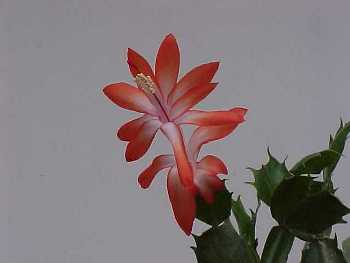

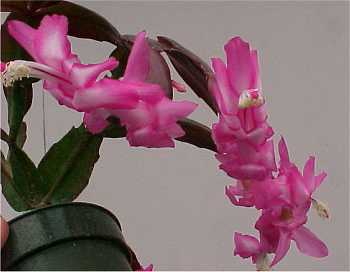
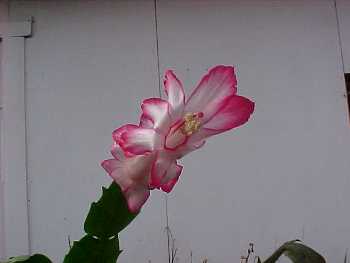
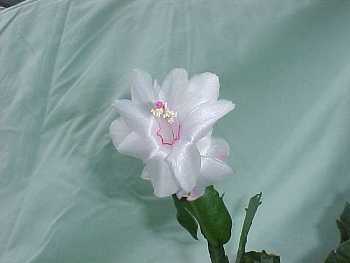
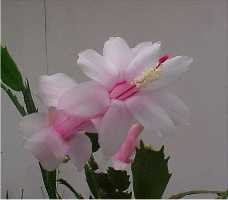
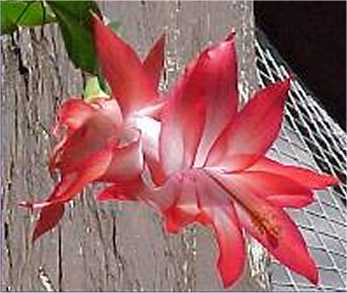
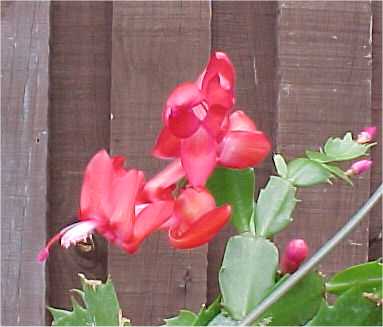
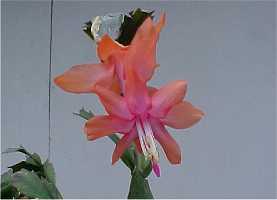
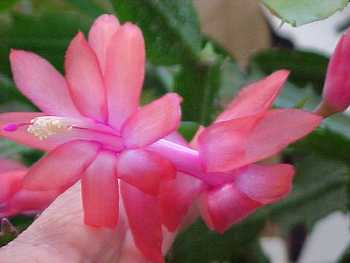
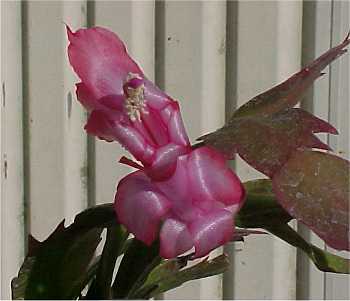
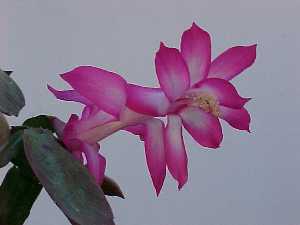
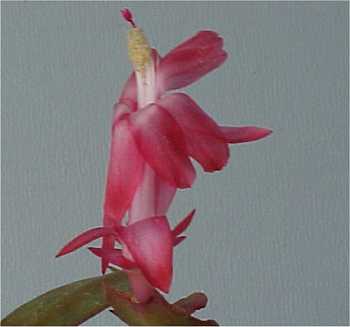

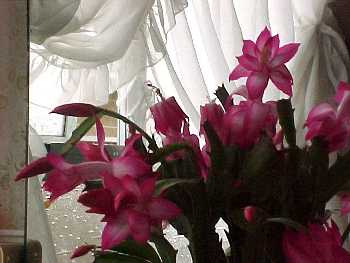
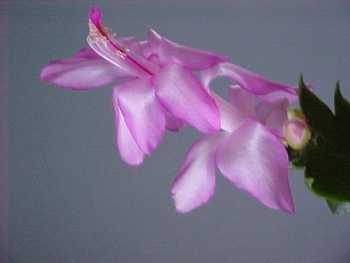
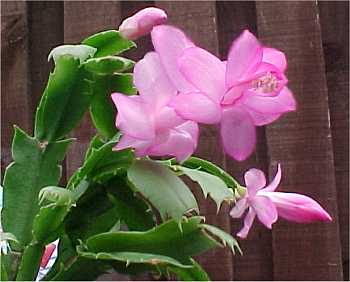

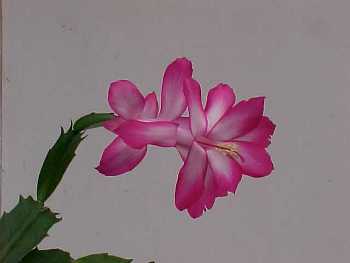
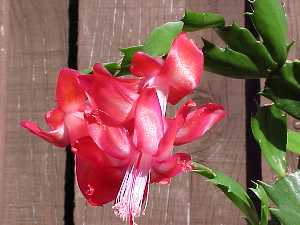
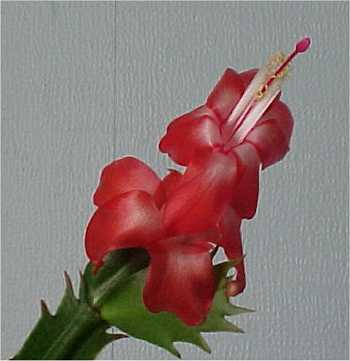
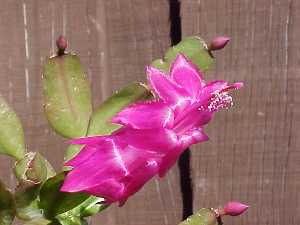
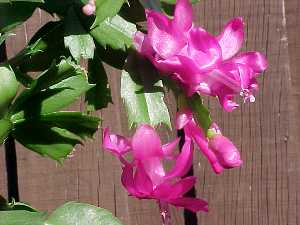
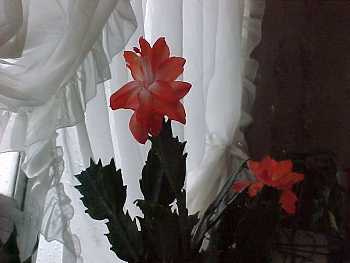
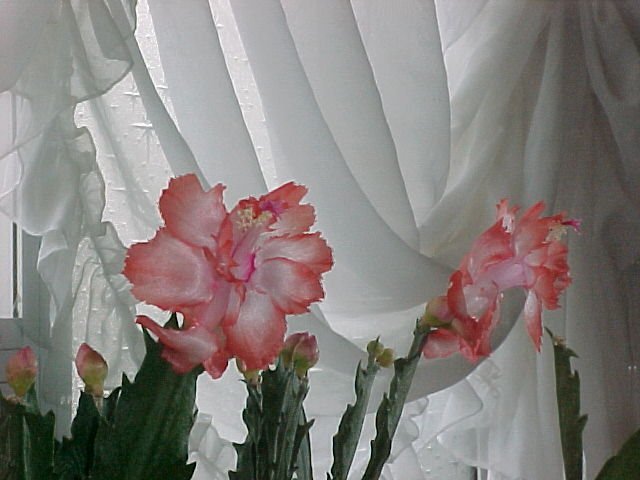

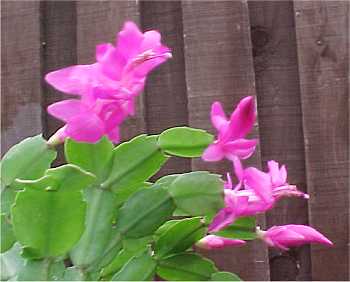
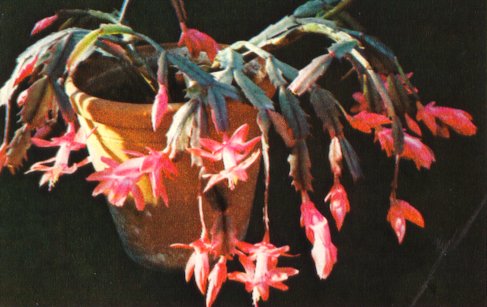


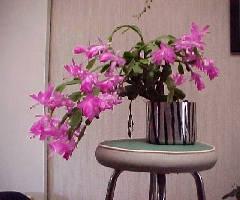




 Flowering: this is controlled by photoperiod (light) and temperature.
In natural conditions this is initiated in March when the day length shortens
i.e. it is the longer nights that trigger flowering, not the shorter days,
and temperatures are around 10 - 15 deg.C.
Flowering: this is controlled by photoperiod (light) and temperature.
In natural conditions this is initiated in March when the day length shortens
i.e. it is the longer nights that trigger flowering, not the shorter days,
and temperatures are around 10 - 15 deg.C.
